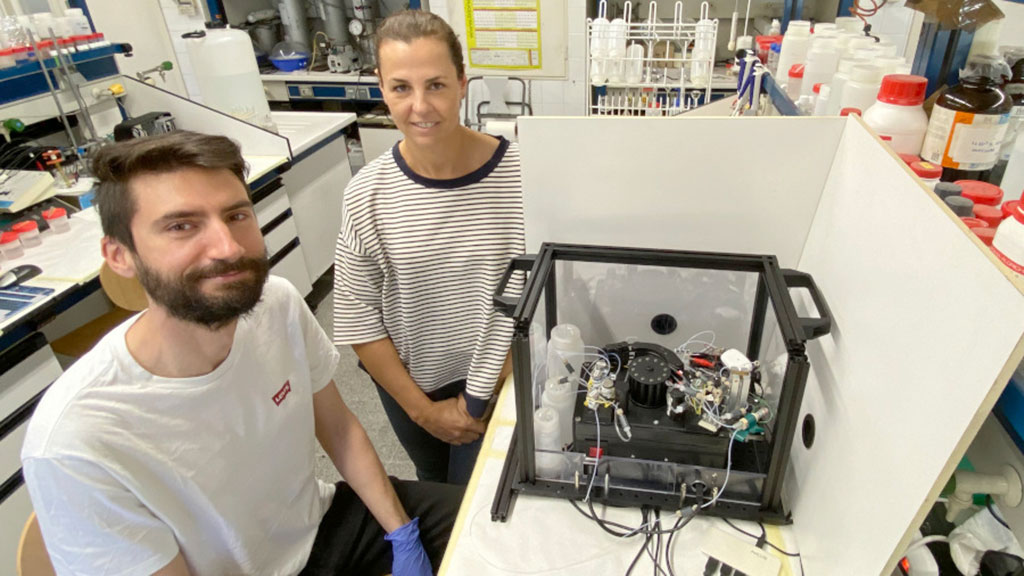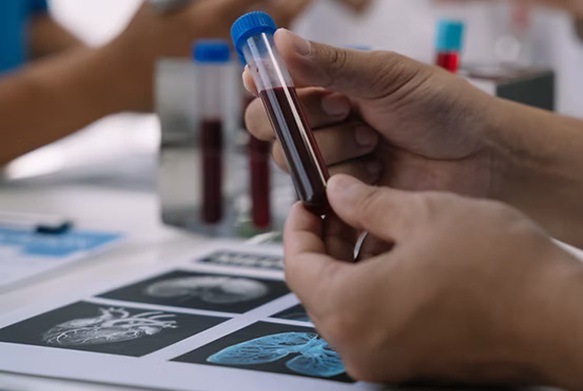New Analyzer Monitors Blood Ammonium Levels at POC to Facilitate Quick Medical Decisions
|
By LabMedica International staff writers Posted on 04 Nov 2022 |

Ammonium is a biomarker used to diagnose a series of rare hereditary metabolic disorders, such as the primary disorders of the urea cycle and different organic acidemias, as well as other metabolic and environmental conditions affecting the liver’s function, which can cause a secondary dysfunction of the urea cycle. Ammonium is also useful in the study and monitoring of different hepatopathies (diseases affecting the normal functioning of the liver) caused by the consumption of alcohol or other drugs, medicines and other environmental factors. In all of these disorders, an excess of ammonium is produced, putting the patient’s health at risk. Values surpassing 200 micromoles per liter of blood are considered severe cases of hyperammonemia (high concentration of ammonium in blood) which can cause irreversible damage to the brain, and can even lead to death, if values surpass 500 micromoles per liter. Therefore, an early diagnosis in real time is crucial to minimizing the impact of a hyperammonemia episode on neurological functions. Currently, patients diagnosed with disorders which include hyperammonemia episodes must periodically be visited at hospital, where a blood sample is taken, which then must be treated an analyzed in the lab.
Now, researchers at the Autonomous University of Barcelona (UAB, Barcelona, Spain) have developed an analyzer that monitors the level of ammonium in the patient’s blood using a decentralized method at the point-of-care, instead of sending blood samples to be analyzed in hospital laboratories, where traditional equipment is used. The new device aims to decentralize the blood ammonium determination, making the analysis possible at smaller healthcare centers with direct blood measurements and no need for previous treatments. This would represent multiplying the number of monitoring sites, simplifying the process and reducing the time needed to take medical decisions.
The device uses a microfluidic platform which includes a potentiometric detection system and a gas separation membrane. In this manner, it is possible to automatically separate the ammonium in the form of ammonia from the rest of the complex matrix of blood, obtaining a selective detection free of any other type of interferences. This guarantees a precise and exact determination of ammonium concentration in whole blood and not in plasma, which is the method conventionally used to analyze this parameter. The research team is preparing a prototype that will function under semi-autonomous conditions. Once the device is ready, it will measure all ammonium samples analyzed with the conventional method and with the new equipment created by researchers.
“Increasing the frequency of blood analyses to determine ammonium levels is of vital importance,” explained UAB researcher Mar Puyol, director of the study. She goes on to say that: “Reducing the excess of ammonium in a patient with hyperammonemia is done by restricting protein intake, using drugs to enhance ammonium elimination, and dialysis and hemofiltration in the most acute cases, so that the evolution of the patient will be more favorable the faster the doctors act, and that can be achieved by using the point-of-care analyzers such as the one we have developed.”
Puyol warns that “hundreds of samples will be necessary before the final prototype of the point-of-care analyzer is validated. The next stage will then be industrializing the device to launch it into the market. There are still several stages before reaching that scenario, but the device is expected to become an economic alternative that can facilitate the monitoring of liver diseases in developing countries as well.”
Related Links:
UAB
Latest Clinical Chem. News
- ‘Brilliantly Luminous’ Nanoscale Chemical Tool to Improve Disease Detection
- Low-Cost Portable Screening Test to Transform Kidney Disease Detection
- New Method Uses Pulsed Infrared Light to Find Cancer's 'Fingerprints' In Blood Plasma
- Carbon Nanotubes Help Build Highly Accurate Sensors for Continuous Health Monitoring
- Paper-Based Device Boosts HIV Test Accuracy from Dried Blood Samples
- AI-Powered Raman Spectroscopy Method Enables Rapid Drug Detection in Blood
- Novel LC-MS/MS Assay Detects Low Creatinine in Sweat and Saliva
- Biosensing Technology Breakthrough Paves Way for New Methods of Early Disease Detection
- New Saliva Test Rapidly Identifies Paracetamol Overdose
- POC Saliva Testing Device Predicts Heart Failure in 15 Minutes

- Screening Tool Detects Multiple Health Conditions from Single Blood Drop
- Integrated Chemistry and Immunoassay Analyzer with Extensive Assay Menu Offers Flexibility, Scalability and Data Commutability
- Rapid Drug Test to Improve Treatment for Patients Presenting to Hospital
- AI Model Detects Cancer at Lightning Speed through Sugar Analyses
- First-Ever Blood-Powered Chip Offers Real-Time Health Monitoring
- New ADLM Guidance Provides Expert Recommendations on Clinical Testing For Respiratory Viral Infections
Channels
Molecular Diagnostics
view channel
Simple Blood Test Better Predicts Heart Disease Risk
Cardiovascular diseases (CVDs) are the primary cause of death worldwide. A large proportion of these cases could be prevented by addressing lifestyle and environmental factors such as smoking, poor diet,... Read more
New Blood Test Detects 12 Common Cancers Before Symptoms Appear
Bowel cancer is the fourth most common cancer in the UK, with over 42,000 new diagnoses each year. Detecting bowel cancer in its early stages can be challenging, and as the disease progresses, survival... Read moreHematology
view channel
New Scoring System Predicts Risk of Developing Cancer from Common Blood Disorder
Clonal cytopenia of undetermined significance (CCUS) is a blood disorder commonly found in older adults, characterized by mutations in blood cells and a low blood count, but without any obvious cause or... Read more
Non-Invasive Prenatal Test for Fetal RhD Status Demonstrates 100% Accuracy
In the United States, approximately 15% of pregnant individuals are RhD-negative. However, in about 40% of these cases, the fetus is also RhD-negative, making the administration of RhoGAM unnecessary.... Read moreImmunology
view channel
Stem Cell Test Predicts Treatment Outcome for Patients with Platinum-Resistant Ovarian Cancer
Epithelial ovarian cancer frequently responds to chemotherapy initially, but eventually, the tumor develops resistance to the therapy, leading to regrowth. This resistance is partially due to the activation... Read more
Machine Learning-Enabled Blood Test Predicts Immunotherapy Response in Lymphoma Patients
Chimeric antigen receptor (CAR) T-cell therapy has emerged as one of the most promising recent developments in the treatment of blood cancers. However, over half of non-Hodgkin lymphoma (NHL) patients... Read moreMicrobiology
view channel
Handheld Device Delivers Low-Cost TB Results in Less Than One Hour
Tuberculosis (TB) remains the deadliest infectious disease globally, affecting an estimated 10 million people annually. In 2021, about 4.2 million TB cases went undiagnosed or unreported, mainly due to... Read more
New AI-Based Method Improves Diagnosis of Drug-Resistant Infections
Drug-resistant infections, particularly those caused by deadly bacteria like tuberculosis and staphylococcus, are rapidly emerging as a global health emergency. These infections are more difficult to treat,... Read more
Breakthrough Diagnostic Technology Identifies Bacterial Infections with Almost 100% Accuracy within Three Hours
Rapid and precise identification of pathogenic microbes in patient samples is essential for the effective treatment of acute infectious diseases, such as sepsis. The fluorescence in situ hybridization... Read morePathology
view channel
Sensitive and Specific DUB Enzyme Assay Kits Require Minimal Setup Without Substrate Preparation
Ubiquitination and deubiquitination are two important physiological processes in the ubiquitin-proteasome system, responsible for protein degradation in cells. Deubiquitinating (DUB) enzymes contain around... Read more
World’s First AI Model for Thyroid Cancer Diagnosis Achieves Over 90% Accuracy
Thyroid cancer is one of the most common cancers worldwide, and its precise management typically relies on two primary systems: (1) the 8th edition of the American Joint Committee on Cancer (AJCC) or ... Read more
Breakthrough Diagnostic Approach to Significantly Improve TB Detection
Tuberculosis (TB) remains the deadliest infectious disease globally, with 10.8 million new cases and 1.25 million deaths reported in 2023. Early detection through effective screening is crucial in identifying... Read more
Rapid, Ultra-Sensitive, PCR-Free Detection Method Makes Genetic Analysis More Accessible
Genetic testing has been an important method for detecting infectious diseases, diagnosing early-stage cancer, ensuring food safety, and analyzing environmental DNA. For a long time, polymerase chain reaction... Read moreTechnology
view channel
Disposable Microchip Technology Could Selectively Detect HIV in Whole Blood Samples
As of the end of 2023, approximately 40 million people globally were living with HIV, and around 630,000 individuals died from AIDS-related illnesses that same year. Despite a substantial decline in deaths... Read more
Pain-On-A-Chip Microfluidic Device Determines Types of Chronic Pain from Blood Samples
Chronic pain is a widespread condition that remains difficult to manage, and existing clinical methods for its treatment rely largely on self-reporting, which can be subjective and especially problematic... Read more
Innovative, Label-Free Ratiometric Fluorosensor Enables More Sensitive Viral RNA Detection
Viruses present a major global health risk, as demonstrated by recent pandemics, making early detection and identification essential for preventing new outbreaks. While traditional detection methods are... Read moreIndustry
view channel
Cepheid and Oxford Nanopore Technologies Partner on Advancing Automated Sequencing-Based Solutions
Cepheid (Sunnyvale, CA, USA), a leading molecular diagnostics company, and Oxford Nanopore Technologies (Oxford, UK), the company behind a new generation of sequencing-based molecular analysis technologies,... Read more
Grifols and Tecan’s IBL Collaborate on Advanced Biomarker Panels
Grifols (Barcelona, Spain), one of the world’s leading producers of plasma-derived medicines and innovative diagnostic solutions, is expanding its offer in clinical diagnostics through a strategic partnership... Read more




















